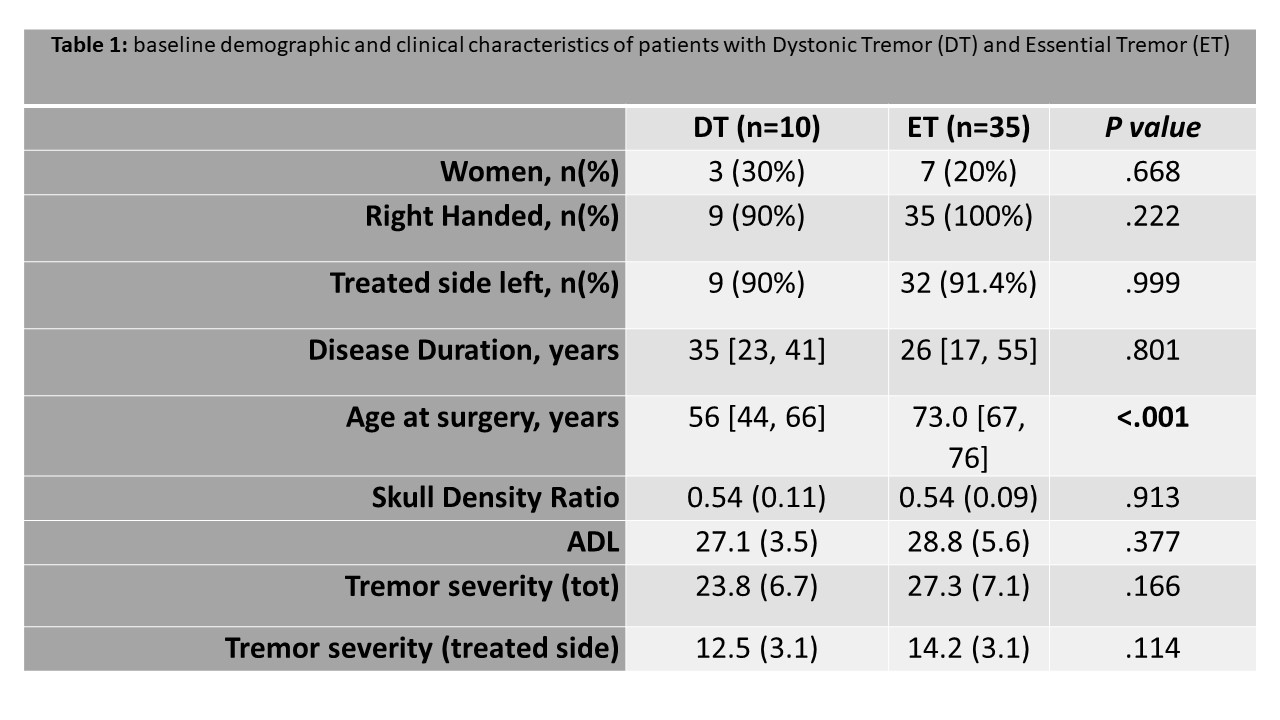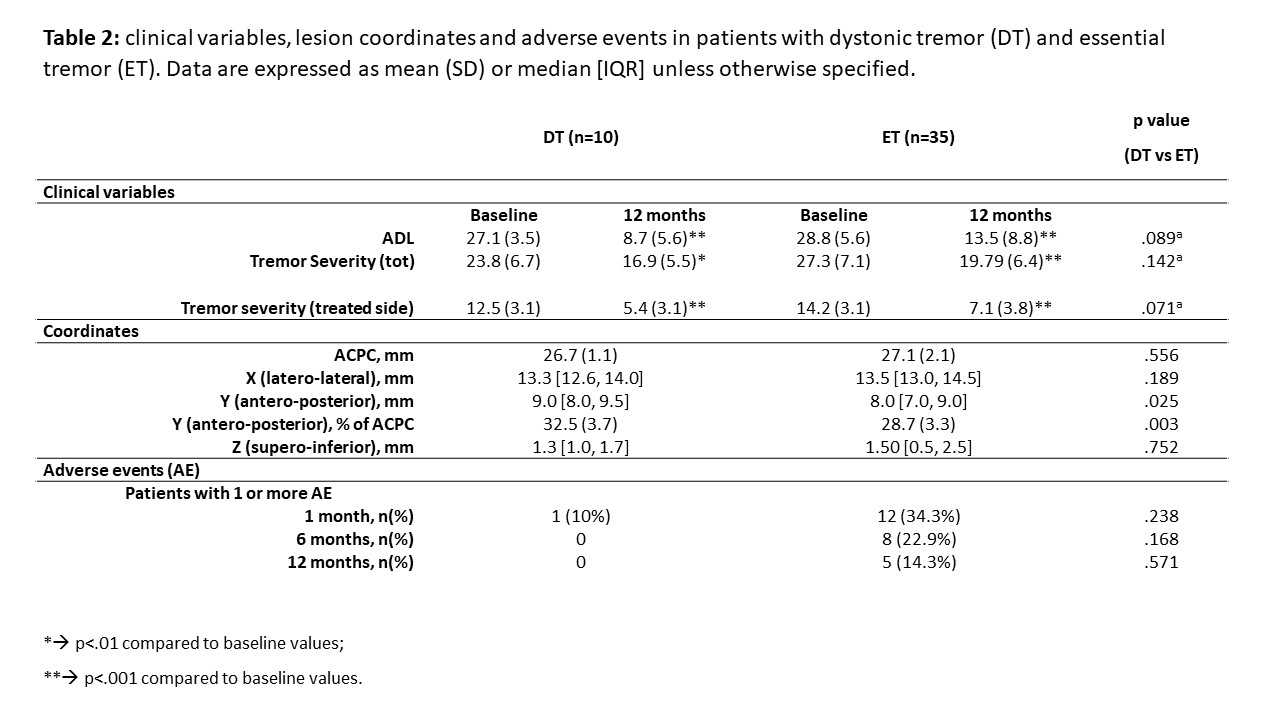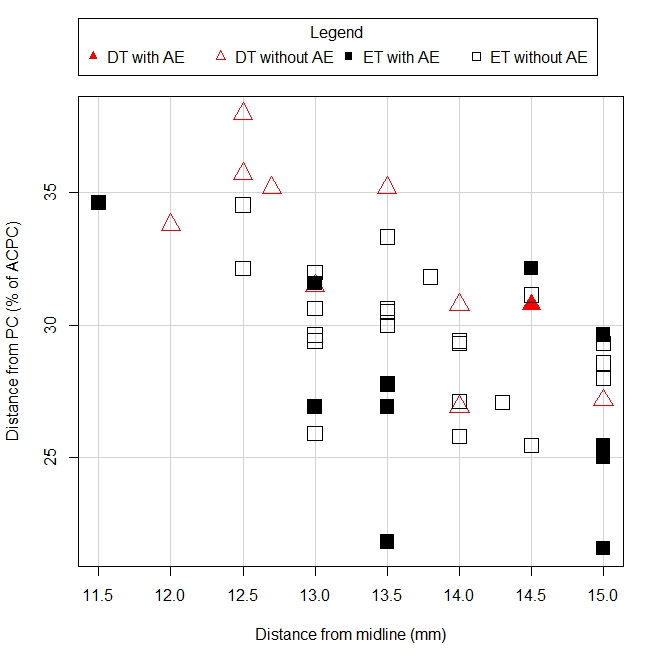Objective: The primary objective of this study was to evaluate the effectiveness of MRgFUS thalamotomy in patients with Dystonic Tremor (DT) compared with patients with Essential Tremor (ET). The secondary objectives were to compare the adverse events profile and the coordinates of the thalamic lesions in the two groups.
Background: MRgFUS thalamotomy is safe and effective to treat drug-resistant tremor in patients with ET [1]. Data on MRgFUS thalamotomy in DT are scarce and, to the best of our knowledge, limited to one case series [2]. Moreover, there is still no consensus on which target to prefer for the surgical treatment in DT patients [3].
Method: Patients with DT and ET treated with MRgFUS thalamotomy were prospectively enrolled and followed for 12 months after thalamotomy. Clinico-demographic data were collected at baseline (before surgery) and at 12-months follow-up visit. The TETRAS scale was used to evaluate severity of tremor [4]. An MRI collected one month after surgery was used to evaluate the lesion coordinates.
Results: Data on 10 patients with DT and 35 with ET were available for statistical analysis. Baseline and clinical characteristics were similar between DT and ET patients, except for age at surgery, with DT patients significantly younger than ET (Table 1). Improvement in Activities of Daily Living and tremor severity resulted similar between DT and ET patients. The thalamic lesion was positioned significantly more anterior in DT compared to ET (Table 2). Thalamotomy-related adverse events were comparable between the two groups (Table 2, Figure). Considering the whole sample, however, a more anterior lesion location was associated with a reduced odds ratio for adverse events (OR=0.773, 95%CI [0.622-0.960], p=0.02).
Conclusion: MRgFUS thalamomy is safe and effective in patients with DT and ET; a more anterior initial targeting may be considered for DT patients, instead of classical Vim coordinates.
References: [1] Elias WJ, Lipsman N, Ondo WG, et al (2016) A Randomized Trial of Focused Ultrasound Thalamotomy for Essential Tremor. New Engl J Medicine 375:730–739. https://doi.org/10.1056/nejmoa1600159
[2] Fasano A, Llinas M, Munhoz RP, et al (2017) MRI-guided focused ultrasound thalamotomy in non-ET tremor syndromes. Neurology 89:771–775. https://doi.org/10.1212/wnl.0000000000004268
[3] Mongardi L, Rispoli V, Scerrati A, et al (2020) Deep brain stimulation of the ventralis oralis anterior thalamic nucleus is effective for dystonic tremor. Parkinsonism Relat D 81:8–11. https://doi.org/10.1016/j.parkreldis.2020.09.040
[4] Elble R, Comella C, Fahn S, et al (2012) Reliability of a new scale for essential tremor. Mov Disord 27:1567–1569. https://doi.org/10.1002/mds.25162
To cite this abstract in AMA style:
N. Golfrè Andreasi, A. Braccia, F. Ghielmetti, LM. Romito, R. Cilia, AE. Elia, G. Devigili, G. Messina, V. Levi, S. Rinaldo, M. Corradi, G. Barbiera, F. Paio, M. Stanziano, S. Prioni, P. Amami, M. Fusarpoli, SHM. Piacentini, MG. Bruzzone, M. Grisoli, EFM. Ciceri, R. Eleopra. MRgFUS thalamotomy in dystonic and essential tremor: a prospective study with one year follow up [abstract]. Mov Disord. 2023; 38 (suppl 1). https://www.mdsabstracts.org/abstract/mrgfus-thalamotomy-in-dystonic-and-essential-tremor-a-prospective-study-with-one-year-follow-up/. Accessed December 13, 2025.« Back to 2023 International Congress
MDS Abstracts - https://www.mdsabstracts.org/abstract/mrgfus-thalamotomy-in-dystonic-and-essential-tremor-a-prospective-study-with-one-year-follow-up/



